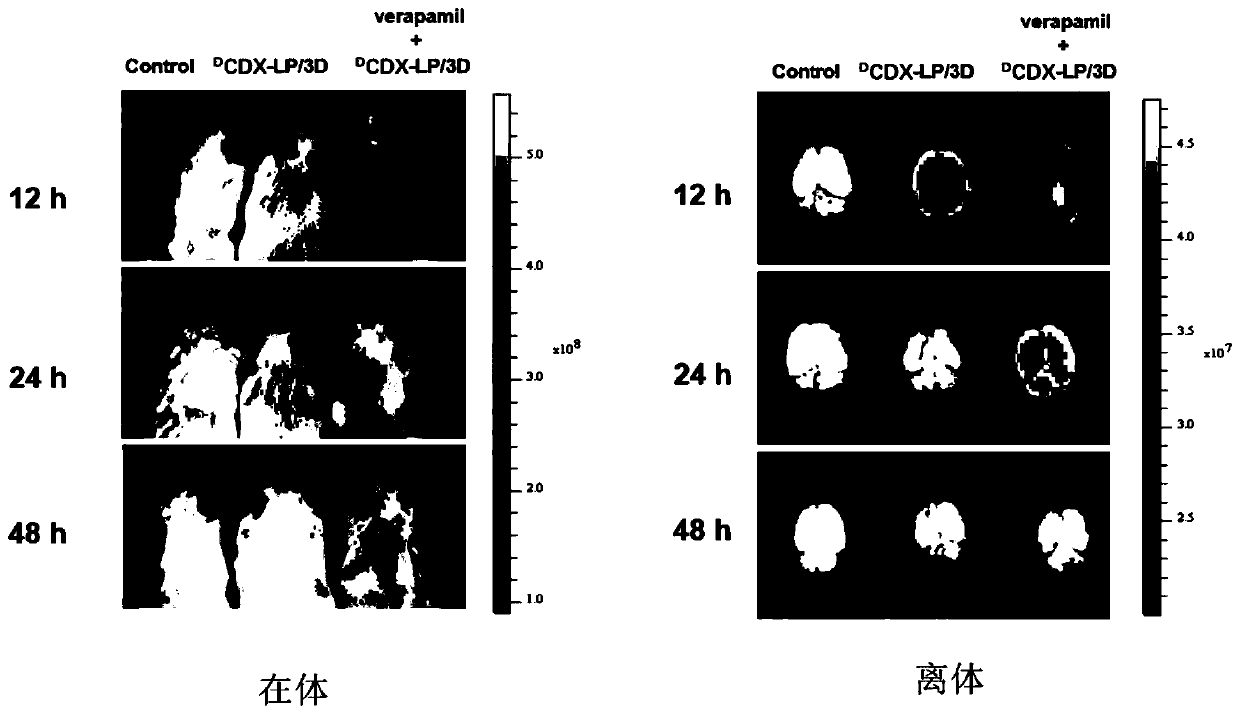Application of P-glycoprotein inhibitors in drug delivery system modified by DCDX
A glycoprotein inhibitor and drug delivery system technology, applied in the field of biopharmaceuticals, can solve the problems of low quality of life of patients, clean tumor resection, and lack of in-depth research.
- Summary
- Abstract
- Description
- Claims
- Application Information
AI Technical Summary
Problems solved by technology
Method used
Image
Examples
Embodiment 1D
[0053] Example 1 D Construction and characterization of CDX-liposome drug delivery system
[0054] This example discloses a DCDX-liposome drug delivery system construction and characterization method, which specifically includes the following steps:
[0055] (1) Preparation and characterization of membrane materials: first react DCDX-Cys with Mal-PEG-DSPE (phospholipid polyethylene glycol maleimide), freeze-dry to obtain DCDX-PEG-DSPE, then according to HSPC / Chol / mPEG2000 -DSPE / DCDX-PEG-DSPE (52:43:3:2, mol / mol) formula to prepare DCDX modified PEG (polyethylene glycol) liposome membrane material. The DCDX-PEG-DSPE that Mal-PEG-DSPE and above-mentioned steps obtain is dissolved in CDCl3, nuclear magnetic resonance instrument detects its nuclear magnetic spectrum, test result is as follows figure 1 shown. figure 1 Figure A in the middle is the 1H-NMR spectrum of Mal-PEG-DSPE, and Figure B is the 1H-NMR spectrum of DCDX-PEG-DSPE. Such as figure 1 As shown, Mal-PEG-DSPE show...
Embodiment 2
[0058] Embodiment 2 Verapamil to D Effect of CDX-Liposome Drug Delivery System on Brain Targeting
[0059] (1) In vivo / ex vivo near-infrared investigation of brain targeting effects: in order to detect P-gp and D The relationship between CDX-liposome accumulation in the brain, ICR mice were randomly divided into 3 groups: control group, D CDX-liposome set, D CDX-liposome+verapamil group. Specific operation: the three groups of ICR mice were injected with 100 liters into the tail vein respectively D CDX-Liposome / 3D, D CDX-liposome / 3D and normal saline, intraperitoneal injection of verapamil (15mg / kg) to one group of liposome-injected mice, and in vivo fluorescence detection by intravital imager at 12h, 24h and 48h respectively . After the detection, anesthetized with chloral hydrate, cardiac perfusion with normal saline, removed the brain tissue, and detected the fluorescence intensity of the brain tissue at 12h, 24h and 48h with an in vivo imager. The results were as fol...
Embodiment 3
[0061] Embodiment 3 verapamil to D Anti-glioma effect of CDX-liposome drug delivery system
[0062] (1) Construction of orthotopic glioma model mice: Take U87 cells in the logarithmic growth phase, digest and count the cells, suspend them with an appropriate amount of PBS buffer, and inoculate each nude mouse with 8×10 5 cells. Before the experiment, the nude mice were anesthetized with 8% chloral hydrate, fixed with a brain stereotaxic instrument, and the suspension cells were inoculated in the striatum (0.6 mm forward, 1.8 mm to the right, and 3 mm in depth) of the bregma, and regular observations were made. Status of nude mice after surgery.
[0063] (2) Efficacy test of antigenic glioma: the rats bearing orthotopic glioma were randomly divided into 4 groups (n=8), and injected with 100 g of D CDX-Liposome / Doxorubicin, Saline, Verapamil, 100M, D CDX-liposome / doxorubicin+verapamil, the single injection dose of verapamil was 15mg / kg, and the survival time of the model mice ...
PUM
 Login to View More
Login to View More Abstract
Description
Claims
Application Information
 Login to View More
Login to View More - R&D
- Intellectual Property
- Life Sciences
- Materials
- Tech Scout
- Unparalleled Data Quality
- Higher Quality Content
- 60% Fewer Hallucinations
Browse by: Latest US Patents, China's latest patents, Technical Efficacy Thesaurus, Application Domain, Technology Topic, Popular Technical Reports.
© 2025 PatSnap. All rights reserved.Legal|Privacy policy|Modern Slavery Act Transparency Statement|Sitemap|About US| Contact US: help@patsnap.com



